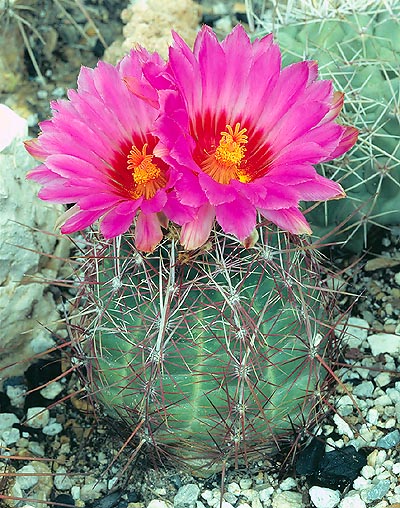Family : Cactaceae

Text © Pietro Puccio

English translation by Mario Beltramini

Multicoloured thorns, showy blooming and easy tillage© G. Mazza
The name of the genus comes from the combination of the Greek word “thelé” = nipple and Cactus, with reference to the tubercles on the ribs; the name of the species is the Latin word “bicolor”= bicoloured, with reference to the colour and the bands of the thorns.
Common names: “glory of Texas”, “marathon basin thelocactus”, “Texas pride” (English); “biznaga-pezón bicolor”, “gloria de Texas” (Spanish).
The Thelocactus bicolor (Galeotti) Britton & Rose (1922), very variable plant with a rather slow growth, has a single stem, rarely ramified at the base, of ovoid or cylindric ovate shape, of a colour going from the green to the green-grey or yellowish-green, 10-15 cm tall and with a diameter of 5 to 10 cm, even if old specimens, in the wild, may reach the 26-28 cm of height and 16 cm of diameter.
The 8-12 ribs are broad and slightly tuberculate, spirally placed especially in the oldest specimens, with downy circular areoles spaced of 0,8-2 cm. The areoles are equipped with 9 to 18 variously gradated red radial thorns, and yellowish apex, long up to about 3 cm, and 1 to 4 central, straight thorns, 3-5 cm long, of the same colour. The bell-shaped flowers originate at the apex of the more recent areoles, are long 5-6 cm, with ovary and floral tube covered by imbricate, thin and membranous scales with fimbriate margins, the outer tepals are of a pale pink colour with a greenish-pink central band, the inner ones are purple pink, more intense at the base, thus forming a well evident central dot. The fruits are oblong, 1-1,5 cm long and 0,5-1 cm of diameter, of green to brown red colour, and covered by fimbriate scales; the seeds are obovoid, about 2 mm long, of black colour.
It usually reproduces by seed, seen that it seldom ramifies. The vast area of origin, the presence at very varied altitudes and its own intrinsic variability, have originated many local forms which have been described, during the time, as varieties or subspecies, and are now considered by many botanists as synonyms, but on such thing there is not yet a full agreement.
Plant of easy cultivation, probably the most cultivated in the genus, much appreciated due to its multi-coloured thorns which almost cover its whole surface and the showy blooming. It must be placed in full sun, or, however, at the maximum possible luminosity, on particularly porous and draining soils which may be formed by common fertilized garden earth, coarse sand (or agri-perlite) and crushed dust-free stone in equal parts. Even if it stands, in dry soil and for a short time, temperatures as low as -7 °C, till -12 °C for some local forms, it is better not to expose it to temperatures lower than 0 °C, especially in presence of humidity; therefore, where the climate does not allow the cultivation in “desert” gardens, it is to be cultivated in pot, with the same aforementioned modalities, in order to shelter it in winter.
In summer, during the vegetative period, it is to be regularly watered, but allowing the soil to dry up completely before irrigating again; in winter it is to be kept dry at temperatures possibly between the +5 and the + 10 °C, this cold and dry period helps its blooming.
The plant is inscribed into the appendix II of the Cites (plant whose trade is ruled at international level).
Synonyms: Echinocactus bicolor Galeotti (1848); Echinocactus rhodophthalmus Hooker (1850); Echinocactus rhodophthalmus var. elliptica Hooker (1852); Echinocactus ellipticus Lemaire (1853); Echinocactus bicolor var. schottii Engelmann (1856); Echinocactus bolaensis Runge (1889); Echinocactus bicolor var. bolansis Schumann (1898); Echinocactus bicolor var. tricolor Schumann (1898); Echinocactus schottii Small (1903); Thelocactus schwarzii Backeb. (1950); Ferocactus bicolor (Galeotti ex Pfeiff.) N.P. Taylor (1979); Ferocactus bicolor var. bolaensis (Runge) N.P. Taylor (1979); Thelocactus bicolor subsp. schwarzii (Backeb.) N.P. Taylor (1998).
